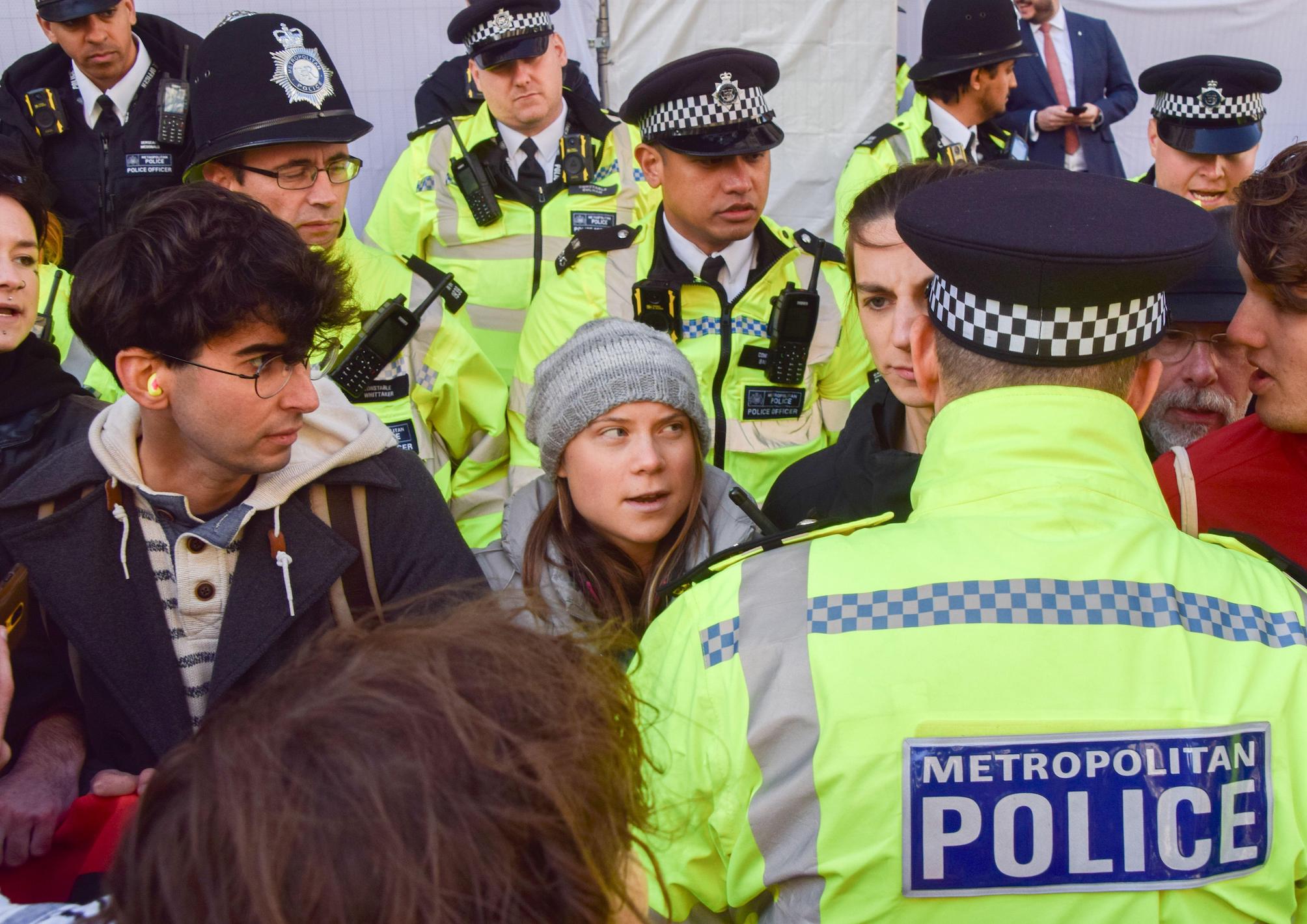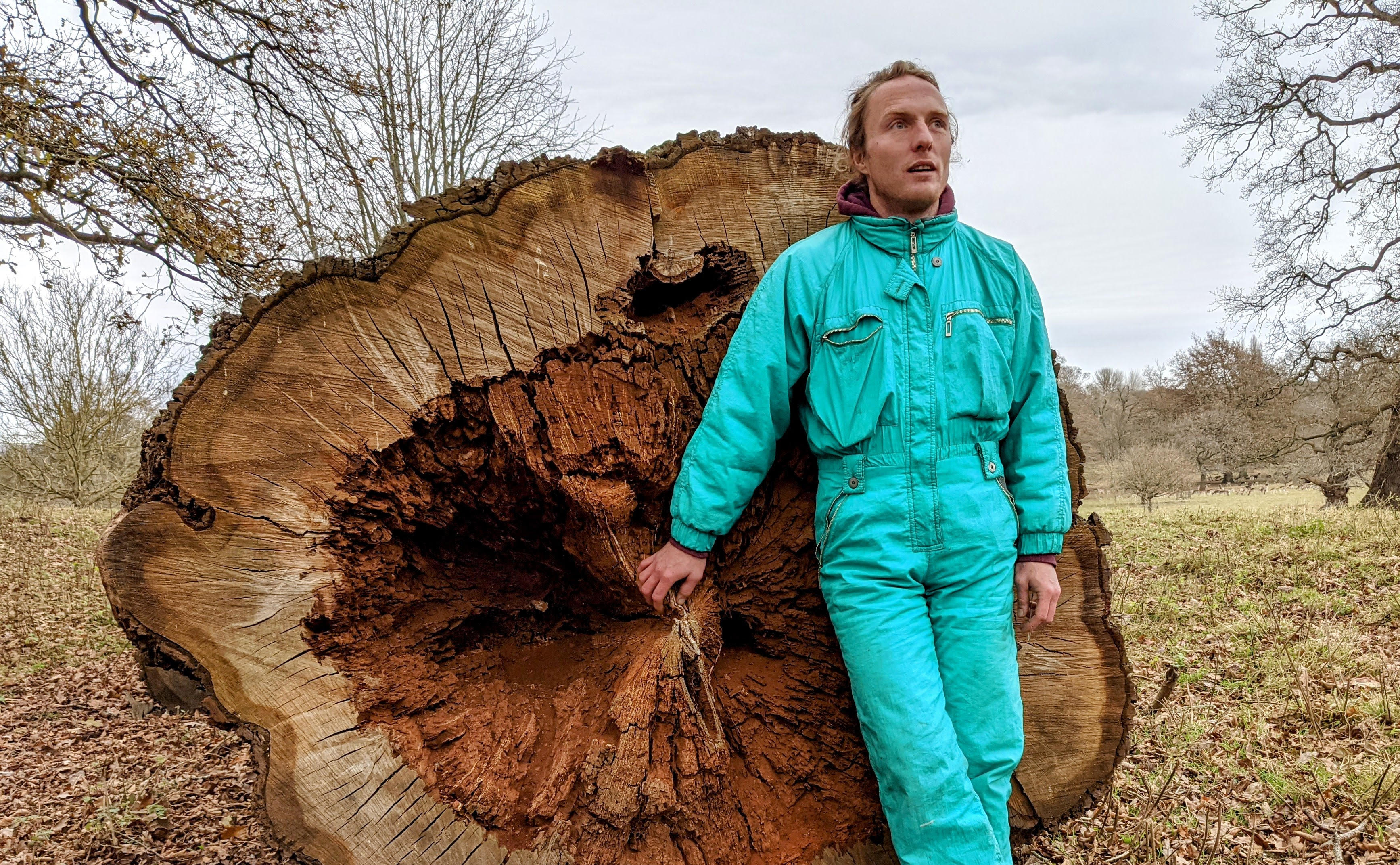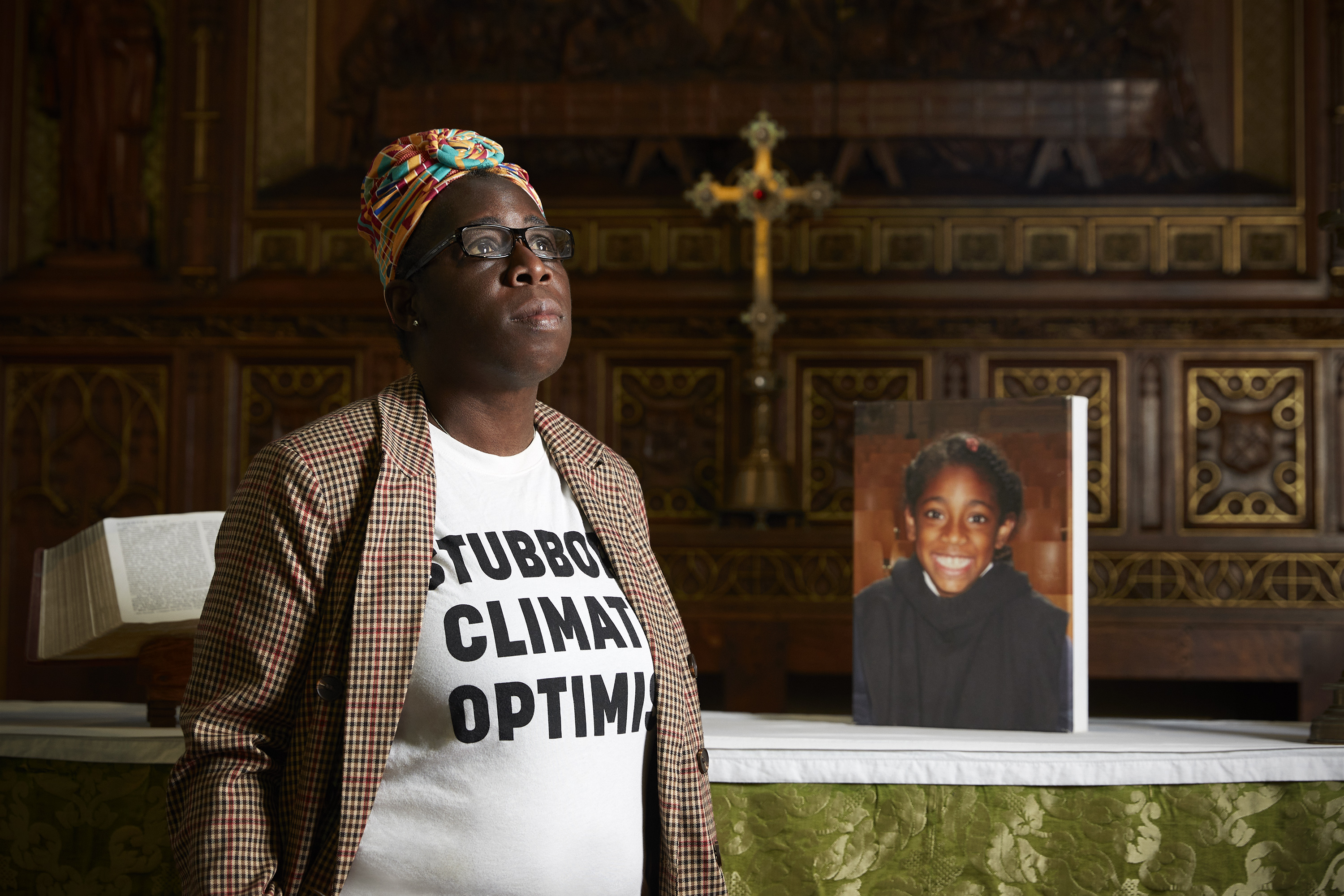The artists fighting sewage spills
Artists are pushing sewage into the spotlight, closing the distance between politicians and pollution. Their work - from surfboards made of shit to the sewer transformed into a tropical paradise - reveals how nature, a vital source of inspiration, is being corrupted by greed and apathy.
In 2023, two Just Stop Oil [JSO] protestors entered the National Gallery and broke the glass covering The Rokeby Venus. It was one of several similar protests that dominated climate coverage last year, triggering a slew of social media debates about direct action and the ethics of protest. Fittingly, the protest came almost 100 years after suffragette Mary Richardson ‘slashed’ the Rokeby Venus with a meat cleaver.
The National Gallery is about half a kilometre from the banks of the Thames. If you follow the river east, you’ll eventually reach Maidenhead, where Sonning Bridge crosses the murky waters. It’s here, three months before JSO’s protest, that a gleaming white urinal appeared on the side of the bridge.
This wasn’t the handiwork of incompetent, or incontinent, town planners. Nor was it the return of Marcel Duchamp, who in 1917 shocked the art world with Fountain, a signed urinal. This was the latest creation by anonymous artist Impro, who erected the urinal to protest pollution in the Thames.
Impro isn’t alone in using art to make a statement about this urgent issue. When sewage pollution isn’t causing sickness, disrupting ecosystems, or defacing natural beauty, it’s also inspiring UK artists. From knitting enthusiasts to Damien Hirst, a wave of creatives are tackling sewage pollution in the gallery and beyond.
According to the Environment Agency, there were 301,091 storm overflow sewage spills into UK waters in 2022 – which River Action UK equates to 824 sewage spills a day. The River Trust says none of the UK’s rivers meet the standards for good overall health. Surfers Against Sewage, meanwhile, highlight that 75% of UK rivers pose a serious risk to human health.
Product designer and surfboard-maker Niall Jones has had plenty of close encounters with sewage.
“It’s been part of my experience in Cornwall for a long time,” he says. “There’s been plenty of surfs where I’ve looked at the water and thought, ‘that’s pretty brown’. It seems everyone has a story like that now.”
Niall’s home remedy – a Diet Coke and a quick shower – wasn’t enough to wash away his disgust. He wanted to do something more direct. In January 2023, Niall started working on The Floater, a surfboard made using real sewage.

The Floater in action
Niall recalls the challenges of creating the board: “There was a moment where I was wading in the sea, trying to collect shitty water, and I wondered: what am I doing?”
“It wasn’t an easy build,” he adds. “The board had to be ridiculously strong to function with dirty water inside. On top of that, we had to make it look nice. The chances are, if you make something out of shit, it’ll look shit.”
Ugliness was, in part, the point. To draw public attention, The Floater had to be as unappealing as its name. However, it also had to be functional. It’s a hard balance to strike, especially when eleven-time European surf champion Ben Skinner was set to test the board in March.
Surprisingly, The Floater floated well. “The board was very nose-heavy, which made it an interesting ride. It also looks sort of nice, somehow,” Niall says. The photoshoot drew a crowd of locals, and The Floater’s gross-out factor won enduring attention. It struck a chord with Ben Skinner, too, who said: “Seeing this board is proof of how shocking it is… it’s really rank.”
“I began surfing over 30 years ago. We used to surf among sewage, tampons and turds. We suffered ear and throat infections."

Niall Jones: “There was a moment where I was wading in the sea, trying to collect shitty water, and I wondered: what am I doing?”
Sewage isn’t the only unusual material in Niall’s studio: he’s also worked on boards from recycled parts. His focus on ‘waste’ materials puts him in good company, recalling the work of artist Ithaka Darin Pappas. Beginning in 1989, artist Darin Pappas created a set of sculptures called The Reincarnation of a Surfboard. Produced from recycled surfboard components, the sculptures are unified by dark blue shades and oceanic iconography.
More recently, in 2013, Lou McCurdy and Chloe Hanks installed the TruCost Super-M-Art in ONCA, Brighton. Recreating a supermarket, McCurdy and Hanks lined shelves with plastic waste gathered from UK beaches. These works grant visibility to unseen consequences lingering at the peripheries of our culture. They also grant waste products new value, inverting the decay at the heart of unbridled consumerism; giving, as Darin Pappas puts it, ‘new life to the discarded’.
Surfers against sewage
TruCost and The Floater were both part of a collaboration with Surfers Against Sewage (SAS), a campaign group formed in 1990. SAS relies on artists to raise awareness and funds for their work. Where The Floater sends what SAS calls a ‘middle finger’ to water companies, boards by artists like Damien Hirst, Banksy, and Jamie Hewlett, bring in funding at auction.
Tim Nunn, Communications Manager for SAS, says: “We take our campaigns from beachfront to front-bench. Whichever way decision-makers look, we want them to be confronted with our stand against the sewage pollution crisis."
The surfboard remains at the centre of SAS’ art campaigns. Like a protestor’s placard, the board is a constrained canvas where artists have to be succinct and snappy. Linked to the natural world and bolstered by surf’s countercultural roots, the surfboard has real political potential.
Among the artists to design boards for SAS is street art veteran Mau Mau. Like Niall, Mau Mau recalls his own watershed moment: “I began surfing over 30 years ago,” he says. “Our local break was at the end of a sewer-pipe. We used to surf among sewage, tampons and turds. We suffered ear and throat infections.
“I started doing designs about it on T-shirts, with slogans like 'eat shit and die'. I always loved skate and surf culture, so it made sense to put my images onto boards.”
One of Mau Mau’s boards, designed for SAS, depicts a mermaid atop a Shell oil barrel. The image echoes The Birth of Venus, with Botticelli’s giant scallop shell transformed into a corporate logo. On the back of the board, a dead cartoon clownfish drifts among leaking barrels. A dire epitaph reads ‘we found Nemo’. The contrast between the idyllic (though corrupted) motif on the board’s front, and the stark imagery on the reverse, aptly reflects the sewage crisis. To sustain an enticing status quo, undesirable elements and inconvenient consequences are pushed out of sight.
It's not the only time Mau Mau has put an environmentalist spin on Disney characters, somehow evading litigation in the process. In another work, he shows Winnie the Pooh living outside McDonald’s, evicted from a bulldozed 100 Acre Woods. Mau Mau describes his use of pop-culture characters as a means of revealing ‘harsh reality’: “I like to use famous characters, as they have an existing narrative I can twist.”
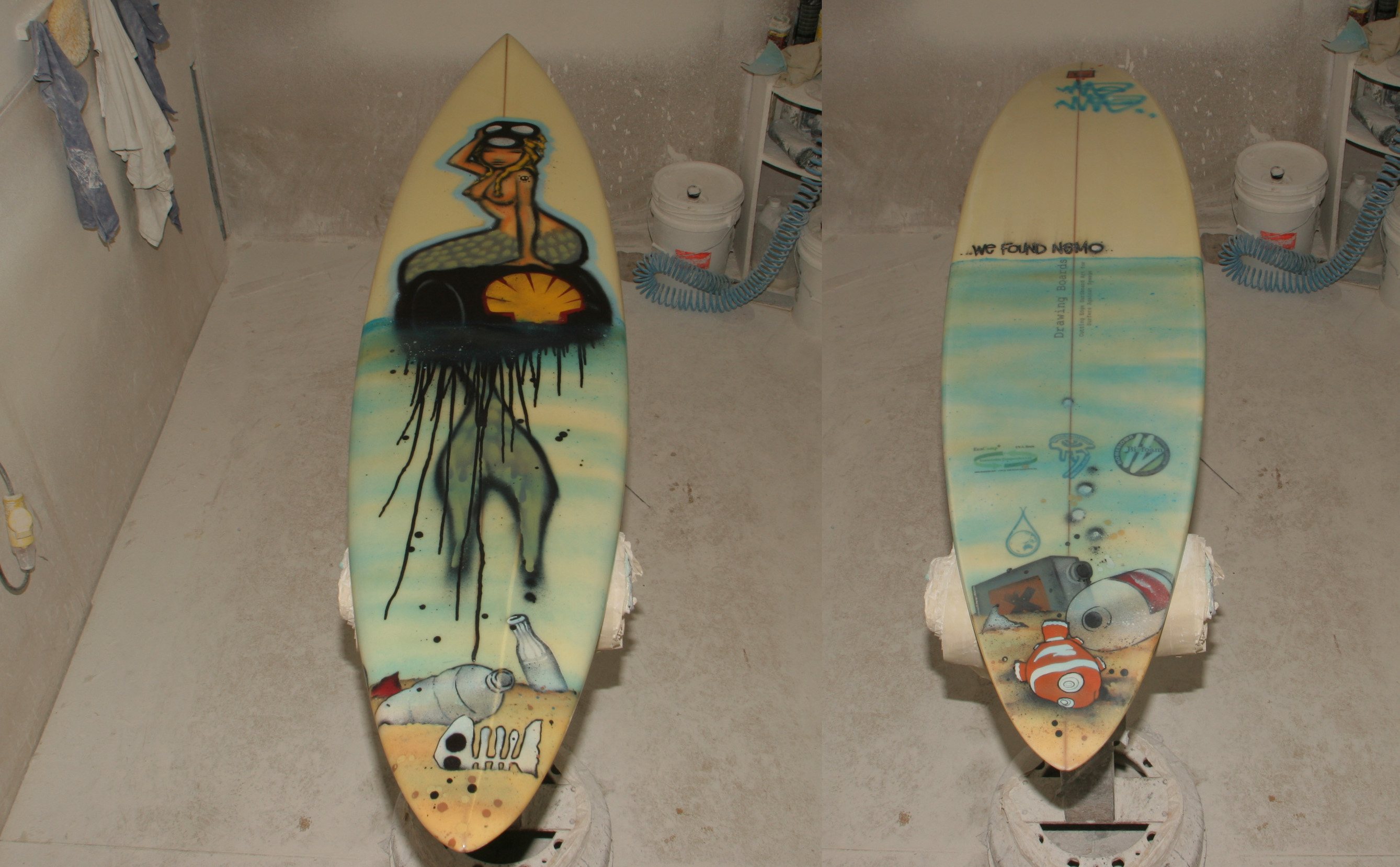
Street art veteran Man Mau's contribution to the SAS project
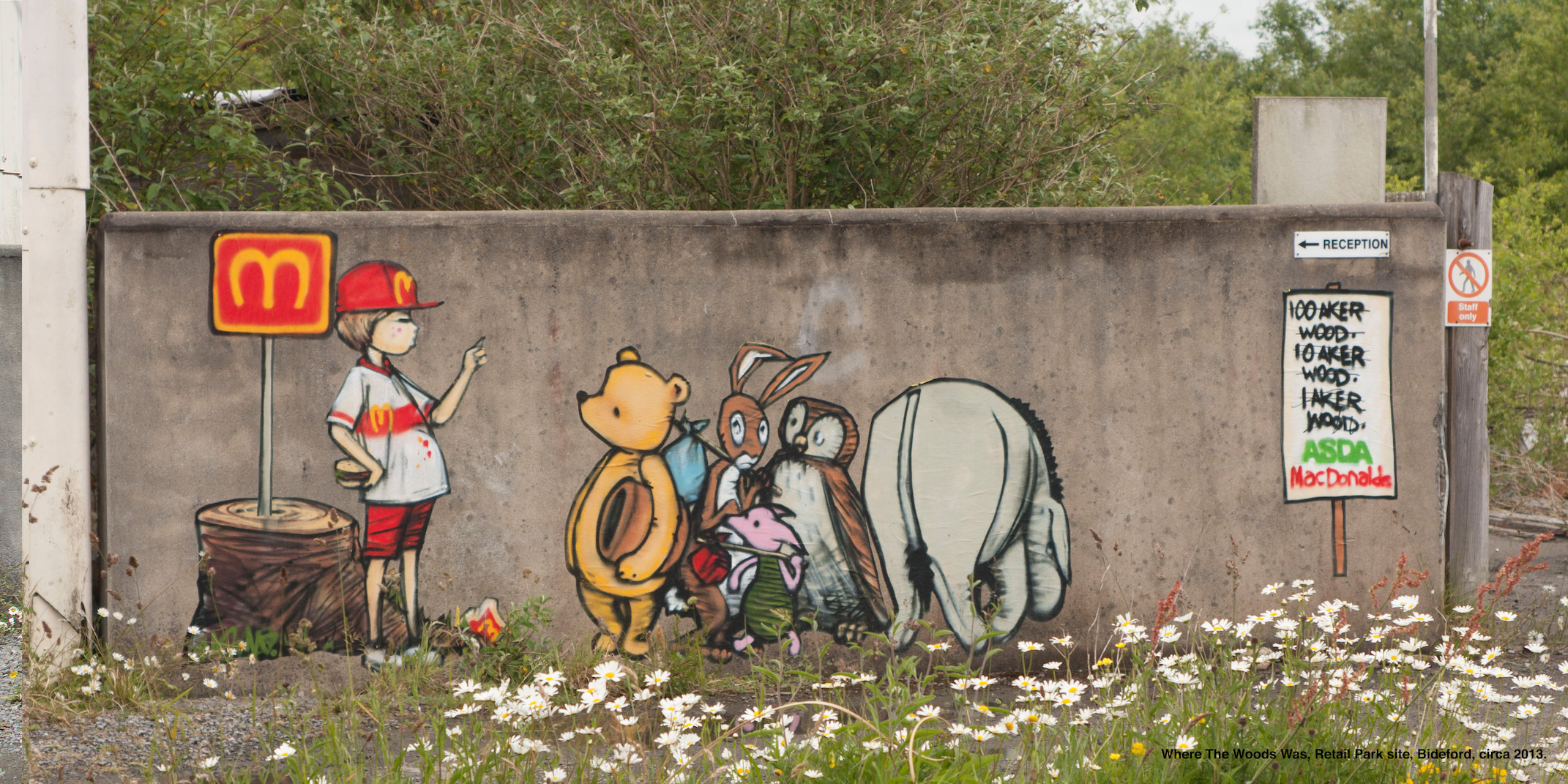
Where the woods was - Mau Mau
Mau Mau sees sewage pollution as part of a wider imbalance: “Much of the media and system is controlled by the rich and greedy, not for the betterment of the people or the planet.” With some water company bosses drawing six-figure salaries, it’s a hard point to contest. As for the art scene, he adds: “There is some good protest art coming out of the UK, but there could be a lot more of it!”
‘Craftivism’ in the fight against sewage
Mau Mau’s wish for more protest art is evidently shared by campaign groups. Extinction Rebellion offers instructions for creating ‘dirty water crime scenes’ with fake police tape and road signs. Environmental group Red Rebels, meanwhile, invites activists to dress up in the Rebels’ provocative, photoshoot-friendly costumes. There’s a clear desire to make protest art accessible to those who don’t have solo shows or art degrees.
‘Craftivism’ lies at the intersection of local action and national organisations. Craftivists often aim for small-scale impacts within the context of wider campaigns. For example, the Leeds Craftivists worked with the RSPB, crafting bees to mail to MPs. In response, Leeds City Council granted permission for wildflowers to be planted at various sites across the city centre. Wildflower beds create ‘networks’ across urban spaces, thereby allowing pollinators to move from place to place. Likewise, the small-scale impact of craftivist groups may culminate in broader changes.
"There were 1,095 sewage dumps in 2022. We decided to stage a protest.”
In September 2023, The National Federation of Women’s Institutes [NFWI] hosted a week of River Action. Local ‘institutes’ across the UK focused on nearby rivers. Groups in Devon and West Yorkshire created artworks; a group in Glemorgan took part in a river clean; members of the Margate Women’s Institute dressed as mermaids outside of Parliament. In Greater Manchester, though, craftivism was arguably at its most provocative. There, the Social Lites Women’s Institute staged a ‘yarn-bombing’ on a bridge over the River Mersey.
Lyn Davies is a committee member for the Social Lites Women’s Institute. She remembers learning about the state of the River Mersey. “We learned from The River Trust that in Stretford and Urmston, there were 1,095 sewage dumps in 2022. We decided to stage a protest,” says Lyn.
Thanks to the Social Lites’ crafts group, a nearby bridge was soon covered with paper fishes, banners, and knitted turds.
The National Federation of Women’s Institutes hosted a week of River Action
“We wanted to get the message out about protecting the river, and the people and wildlife connected to it,” Lyn adds. “Lots of people use the bridge to cycle and walk, and many stopped to learn about the issue. We even had local politicians come by.”
The Social Lites encouraged members of the public to take knitted works home. A week into the display, Lyn came back to find that most of the artworks were gone.
Clearly, local water companies took notice. “United Utilities invited us to visit them and discuss the issue,” Lyn says. However, almost six months later, that meeting is yet to materialise.
Between 1985 and 2010, The Mersey Basin Campaign formed a network of over 20 Action Partnerships. Volunteers and politicians worked together to clean up the river. Cuttlefish and salmon populations surged. As the river faces a new threat, one banner stood out among the yarnbombing’s scatological images. The banner depicted a tranquil River Mersey teeming with swimmers and wildlife. That image connects the past successes of The Mersey Basin Campaign with the Social Lites’ hopes for the future.
The Artist in the sewer
Beyond granting visibility to sewage, artists cast a spotlight on unseen solutions. For The Joy Collective, that meant working 50 metres beneath London.
Tideway’s new ‘super-sewer’ is hardly within public view. To raise awareness for the project, the engineering company has commissioned over 50 artworks around London. The campaign’s scale matches the proportions of the tunnel, yet its aim is simple: to win public support for a project whose concrete tunnels, swathes of sewage, and £4.5bn price tag might otherwise make your eyes water.
Commissioned by Tideway, The Joy Collective created The Loo Gardens within the sewer itself. Though the gardens weren’t as ‘visible’ as Tideway’s other commissions, they encapsulated the project’s promises.
Iona Thomas, founder of The Joy Collective, says The Loo Gardens highlight the sewer’s “massive beneficial impact”:“The super-sewer will reduce the amount of sewage pumped into the Thames from 38 million tonnes per year, to 1 million tonnes per year,” Iona explains. “It’s not perfect, but it will allow wildlife to thrive along the banks of the Thames again.”
The Loo Garden’s imagery and materials reflect this promise. “We chose to reproduce native plants that may be found along the Thames,” Iona adds. “We also moulded the installation’s flowers using plastic waste from the riverbanks. The results were surprisingly beautiful and delicate. We can now reuse those flowers instead of cutting real flowers.”
The Loo Gardens are 50 metres beneath London
“The super-sewer will reduce the amount of sewage pumped into the Thames from 38 million tonnes per year, to 1 million tonnes per year”
"Craftivists and artists are pushing sewage into the spotlight, closing the distance between politicians and pollution. Their work reveals how nature, a vital source of inspiration, is being corrupted by greed and apathy."
Tideway’s super-sewer has its detractors, including former proponent Professor Chris Binnie. Though Professor Binnie chaired the group that recommended the project in 2005, he later criticised its cost, arguing for simpler measures instead. Speaking to WIRED, Dr Tse-Hui Teh, from the Bartlett School of Planning at University College London, said the super-sewer repeats the outdated logic of London’s Victorian sewers.
Tideway, meanwhile, claims the sewer will be effective for 100 years: The Loo Gardens are rooted in that optimism. Only time will tell whether similar gardens, with real plants, will bloom above ground in the coming years.
In The Rokeby Venus, or ‘The Toilet of Venus’, the titular goddess watches herself in the mirror, transfixed. It’s easy to imagine the viewer on similar terms, hypnotised by the painting and, by extension, by a culture of distraction and avoidance. By breaking the glass in front of The Rokeby Venus, JSO sought to shatter that illusion and bring the climate emergency into full view.
It’s the same act of disruption that street artists and craftivists bring to public spaces. Though JSO have been critiqued for being ‘destructive’, their ethos aligns with a number of politically-minded artists. Mau Mau’s surf-culture ‘Venus’, like the knitted excrement over the Mersey, has a comparable effect, reminding us of the dirt beneath the surface.
Craftivists and artists are pushing sewage into the spotlight, closing the distance between politicians and pollution. Their work reveals how nature, a vital source of inspiration, is being corrupted by greed and apathy. Confronting viewers with distant realities, artists also find ways to give new life to ‘waste’.
Like JSO, these artists have their critics. But if Mau Mau or Niall Jones kick up a stink, it’s only because they disrupt an evasive mindset pervading art, consumerism, and contemporary politics. If water companies and politicians don’t mend their ways, artists will long be reaching for the brown paint.
The Lead is now on Substack.
Become a Member, and get our most groundbreaking content first. Become a Founder, and join the newsroom’s internal conversation - meet the writers, the editors and more.


